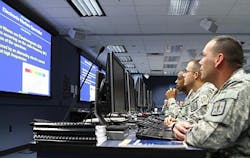Air Force launches spectrum warfare program covering EW, optical, GPS, and cyber warfare
Officials of the Air Force Research Laboratory at Wright-Patterson Air Force Base, Ohio, have released a broad agency announcement (BAA-RQKS-2014-0003) for the Advanced Novel Spectrum Warfare Environment Research (ANSWER) program.
The of ANSWER is to develop adaptive spectrum warfare technologies to maintain warfighting capabilities in contested and denied environments consistent with anti-access/area denial (A2/AD) scenarios, Air Force researchers say.
This solicitation originally had been scheduled for release late last summer or earlier this fall. The ANSWER program previously was known as the Net-Enabled Electronic Warfare Technologies (NEWT) program.
With an ever changing environment between red and blue forces, the ability to control the electromagnetic spectrum is a key requirement to achieving success in warfighter operations, researchers say. This is a daunting task under benign conditions and becomes even more of a challenge as adversaries bring more denial capabilities to bear.
The A2/AD scenario refers to the ability of U.S. and allied military forces to enter and operate efficiently in contested areas on land, at sea, and in the air. At the same time, A2/AD also refers to U.S. and allied military ability to deny then enemy to do the same.
A2/AD describes layered defense across several domains such as land, sea, air, cyber, and space. Weapons such as ultra-quiet diesel submarines, advanced mines, anti-ship weapons, and even cyber or anti-satellite weapons have the potential to slow, stop, or deter enemy combatants from entering a combat zone or contested geographic areas.
If U.S. and allied forces can conduct electromagnetic spectrum operations under A2/AD conditions, then they should be able to operate in other less challenging environments, researchers say.
To accomplish this, the warfighter needs to be able to control the enemy's use of the electromagnetic spectrum, ensure friendly access to and use of the electromagnetic spectrum, protect sensors and avionics, maintain secure communications and data links amid electronic and cyber warfare; and maintain navigation, and timing information.
The ANSWER program is designed to address these challenges. Among the program's thrusts are developing a reconfigurable threat-assessment simulation tool to help assess electronic attack techniques against modern radar tracking.
In today’s RF spectrum battlefield, two types of threats to the warfighter exist: symmetrical and asymmetrical. Symmetrical threats are state-sponsored, and include conventional warfare elements such as networked air defenses. Asymmetrical threats involve individuals or groups that pose threats such as improvised explosive devices (IEDs), commercial cell phones and wireless networks, and computer hacking.
Air defenses can consist of ground based, airborne, and maritime sensors and weapons. Electronic warfare capabilities are needed which can degrade and defeat the air defense capabilities by attacking the system as a whole, the individual components, and the links between those components.
Asymmetrical threats, meanwhile, post a more difficult problem because they are ever-evolving, technically advancing, use unconventional methods, are extremely varied, can stand alone or be connected, can be adaptive, and do not follow military protocol in design or use.
To help counter these threats, Air Force researchers are asking industry for unconventional thinking, to use advanced computing power, and incorporate state-of-the-art signal processing. The program also involves modeling and simulation to analyze and produce metrics to determine their effectiveness and the technical payoffs.
The ANSWER program also involves trusted, cyber-resilient avionics technologies that mitigate potential cyber vulnerabilities to aircraft avionics to keep U.S. technology protected from exploitation.
Other thrusts of the ANSWER program involve anti-tamper and software-protection technologies; GPS-like accuracies to the warfighter in A2/AD); alternatives to GPS; improved inertial systems; ionospheric effects on GPS technology; vision and laser-based navigation; advanced clock technology; and electro-optics countermeasures.
The program will be worth about $47 million, and will involve as many as three contractors. Companies interested should respond no later than 13 Dec. 2013.
For technical questions contact the Air Force's Gary Kaufman by phone at 937-528-8253 or by email at [email protected]. For contracting questions contact the Air Force's Michael Wafzig by phone at 937-255-5762 or by email at [email protected].
More information is online at https://www.fbo.gov/spg/USAF/AFMC/AFRLWRS/BAA-RQKS-2014-0003/listing.html.
